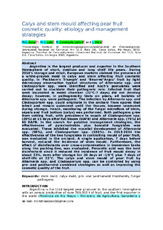- RDI Principal
- →
- Facultad de Ciencias Agrarias
- →
- Artículos
- →
- Ver ítem
JavaScript is disabled for your browser. Some features of this site may not work without it.
Mostrar el registro sencillo del ítem
| dc.creator | Sosa, María Cristina | |
| dc.creator | Lutz, M. Cecilia | |
| dc.creator | Lefort, N.C. | |
| dc.creator | Vera, Lucas | |
| dc.date | 2016 | |
| dc.date.accessioned | 2019-12-02T23:57:25Z | |
| dc.date.available | 2019-12-02T23:57:25Z | |
| dc.identifier | http://rdi.uncoma.edu.ar/handle/uncomaid/15546 | |
| dc.identifier.issn | 0567-7572 | es_ES |
| dc.identifier.issn | 2406-6168 | es_ES |
| dc.description.abstract | Argentina is the largest producer and exporter in the Southern Hemisphere of short, medium and long shelf life pears. During 2014’s storage and retail, European markets claimed the presence of a white-grayish mold in calyx and stem affecting fruit cosmetic quality. In ‘Packham’s Triumph’ and ‘Beurred’Anjou’ fruit by light microscopy observation typical structures of Alternaria spp. and Cladosporium spp. were identified and Koch’s postulates were carried out to elucidate their pathogenic role. Infected fruit that were incubated in moist chamber (22°C-7 days) did not develop decay; however, in pathogenicity tests on pears, all isolates of Alternaria spp. were pathogenic. The infection by Alternaria spp. and Cladosporium spp. could originate in the orchard from spores that infect and remain quiescent until the tissues become senescent during storage. Hence, monitoring of the fungal microflora of stem, sepals and fruit bottom (calyx) was performed. Both pathogens grew from setting fruit, with prevalence in sepals of Cladosporium spp. (20%) at 15 days after full bloom (DAFB) and Alternaria spp. (76%) at 60 DAFB. In the search for putative management strategies, the effectiveness of pyraclostrobin plus boscalid fungicides was evaluated. These inhibited the mycelial development of Alternaria spp. (98%), and Cladosporium spp. (100%). In 2013-2014 the effectiveness of the two fungicides in controlling mould of pear fruit, was evaluated in the orchard. A single application, 7 days before harvest, reduced the incidence of stem mould. Furthermore, the effect of disinfectants over cross-contamination in immersion tanks along the packing-line, was evaluated. Peracetic acid was the best disinfectant since it reduced the incidence of fruit mould decay in about 33%, even after storage for 30 days at -1/0°C plus 7 days of shelf-life at 22°C. The calyx and stem mould of pear fruit by Alternaria spp. and Cladosporium spp. can be controlled by using pre- and postharvest combined strategies as well as improving the cosmetic quality of the fruit. | es_ES |
| dc.format | application/pdf | es_ES |
| dc.format.extent | pp. 245-251 | es_ES |
| dc.language | eng | en |
| dc.publisher | ISHS | es_ES |
| dc.relation.uri | https://www.actahort.org/members/showpdf?booknrarnr=1144_36 | es_ES |
| dc.rights | Atribución-NoComercial-CompartirIgual 2.5 Argentina | es_ES |
| dc.rights.uri | https://creativecommons.org/licenses/by-nc-sa/2.5/ar/ | es_ES |
| dc.source | Acta Horticulturae 1144. ISHS 2016 | es_ES |
| dc.subject | Stem mold | es_ES |
| dc.subject | Calyx mold | es_ES |
| dc.subject | Pre-and postharvest treatments | es_ES |
| dc.subject | Fungal pathogens | es_ES |
| dc.subject.other | Ciencias Agrarias y Forestales | es_ES |
| dc.title | Calyx and stem mould affecting pear fruit cosmetic quality : etiology and management strategies | es_ES |
| dc.type | Articulo | es |
| dc.type | article | eu |
| dc.type | acceptedVersion | eu |
| dc.description.fil | Fil: Sosa, María Cristina. Universidad Nacional del Comahue. Facultad de Ciencias Agrarias; Argentina | es_ES |
| dc.description.fil | Fil: Lutz, M. Cecilia. Universidad Nacional del Comahue. Facultad de Ciencias Agrarias; Argentina | es_ES |
| dc.description.fil | Fil: Vera, Lucas. Universidad Nacional del Comahue. Facultad de Ciencias Agrarias; Argentina | es_ES |
| dc.cole | Artículos | es_ES |



